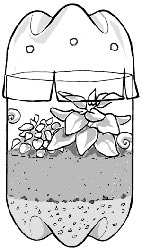Terrariums are miniature gardens grown inside covered clear containers. Use them as a low-maintenance way to enhance your indoor environment, or as a way to teach kids about the water cycle as they witness the fascinating succession of evaporation, condensation, and precipitation in their mini-environment.
Materials List
Choose a container that gives you enough room to reach your hand inside for planting and maintenance. You can make a simple terrarium container by cutting off the top of a 2-liter clear plastic soda bottle. After planting in the bottle, you can either tape the top back on or cover it tightly with plastic.
Clean the container using soapy water and rinse well. Dry completely.
Cover the bottom of the container with small stones to provide drainage. For small containers such as recycled soda bottles, spread stone ?-inch deep; in large containers such as aquarium tanks, spread 1-1/2 inches.
Next, fill the container about one-third to one-half full with moist potting mix. The amount of soil use will depend on the size of the container (you need to have enough room for plant roots to grow).
Time to plant! Purchase for plants that are small, slow-growing, and perform well in humid environments, such as the ones listed below. Most garden centers have an area reserved for indoor plants and you can usually find a variety of plants in 2- to 4-inch pots. Here are some recommendations:
| African violet | artillery fern |
| false aralia | jade plant |
| miniature peperomia | nerve plant |
| oxalis | pink polka dot plant |
| prayer plant | small ferns |
| small peace lilies | small philodendrons |
| spider plant | strawberry begonia |
| Swedish ivy |
Go ahead and experiment with different plants. If they appear to grow too vigorously and crowd other plants, or if they respond poorly to the humidity, remove them and try something new. You can also try growing plants from seeds and cuttings.
Infuse your terrarium with personality - feel free to be creative and add other objects to create mini-landscape scenes. Here are some ideas: decorative rocks; animal figurines; tiny bridges; mirrors (portraying miniature ponds).
After planting, attach the lid or cover with plastic. Place the terrarium in a windowsill with indirect lighting or under grow lights. Do not place it in strong, direct sunlight or water will evaporate too quickly and plants may get scorched.
Observe your terrarium closely for the first few days to make sure you have the proper moisture level:
You'll know that the terrarium contains the right amount of water if the sides and top get misty with water droplets when in bright light.
If there is no moisture along the sides, then you need to add some more water.
If the sides are always very wet and it is hard to see the plants, then there's too much water and you should remove the top for a few hours and allow some of the excess water to evaporate.
Once you achieve the perfect balance, your terrarium will only need periodic monitoring.